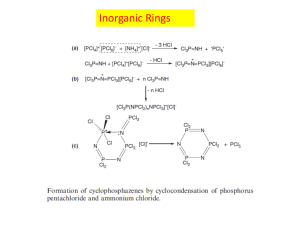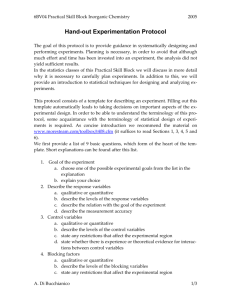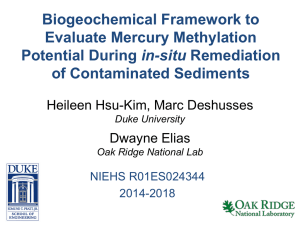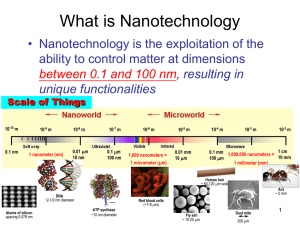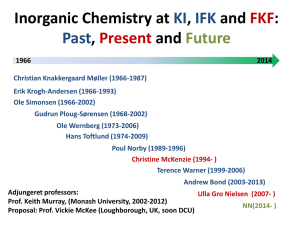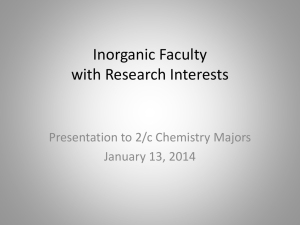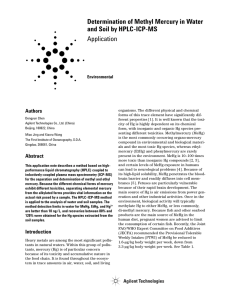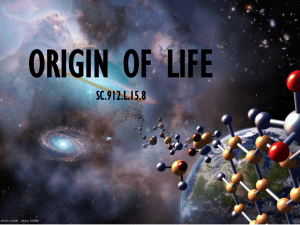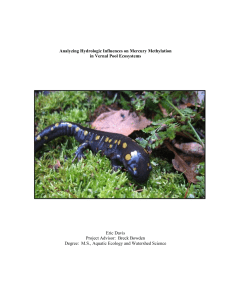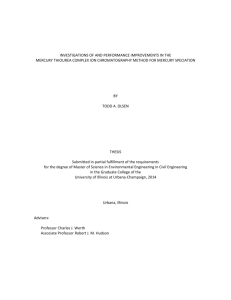word version
advertisement
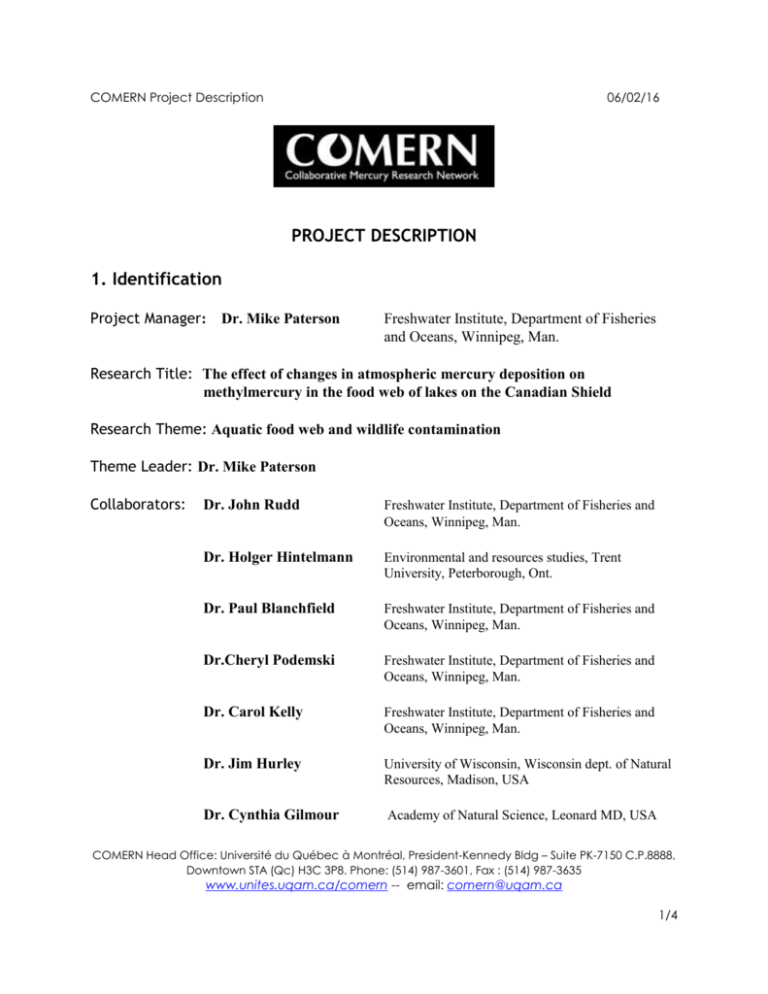
COMERN Project Description 06/02/16 PROJECT DESCRIPTION 1. Identification Project Manager: Dr. Mike Paterson Freshwater Institute, Department of Fisheries and Oceans, Winnipeg, Man. Research Title: The effect of changes in atmospheric mercury deposition on methylmercury in the food web of lakes on the Canadian Shield Research Theme: Aquatic food web and wildlife contamination Theme Leader: Dr. Mike Paterson Collaborators: Dr. John Rudd Freshwater Institute, Department of Fisheries and Oceans, Winnipeg, Man. Dr. Holger Hintelmann Environmental and resources studies, Trent University, Peterborough, Ont. Dr. Paul Blanchfield Freshwater Institute, Department of Fisheries and Oceans, Winnipeg, Man. Dr.Cheryl Podemski Freshwater Institute, Department of Fisheries and Oceans, Winnipeg, Man. Dr. Carol Kelly Freshwater Institute, Department of Fisheries and Oceans, Winnipeg, Man. Dr. Jim Hurley University of Wisconsin, Wisconsin dept. of Natural Resources, Madison, USA Dr. Cynthia Gilmour Academy of Natural Science, Leonard MD, USA COMERN Head Office: Université du Québec à Montréal, President-Kennedy Bldg – Suite PK-7150 C.P.8888, Downtown STA (Qc) H3C 3P8. Phone: (514) 987-3601, Fax : (514) 987-3635 www.unites.uqam.ca/comern -- email: comern@uqam.ca 1/4 COMERN Project Description 06/02/16 2. Project summary One of the major sources of anthropogenic mercury (Hg) to the atmosphere is emission of inorganic Hg from coal-fired utilities, and controls on these emissions have recently been proposed. Once deposited in a lake, inorganic Hg must be converted to toxic methyl mercury (MeHg) by methylating bacteria before accumulating in fish and other biota. An understanding of the links between atmospheric Hg deposition and MeHg in fish is essential because consumption of contaminated fish is the main route of exposure for humans and other sensitive biota. While many Hg experts agree that it is logical to expect levels of atmospheric Hg deposition to be linked directly to levels of MeHg in fish, existing data are insufficient to establish whether this expectation is correct. The lack of predictability comes from the fact that the amount of stored Hg in soils and sediments of terrestrial and aquatic ecosystems is hundreds to thousands times greater than annual atmospheric deposition. Stored or “old” Hg may not be important if the newly deposited Hg is more bioavailable to methylating bacteria. Alternatively, if all Hg is equally bioavailable, the large pool stored in sediments and soils will decrease slowly with lowered deposition rates and the effect of emission controls on MeHg in the environment will be slow. In this study, we will examine the relationship between atmospheric Hg deposition and MeHg in biota by conducting a series of enclosure experiments at the Experimental Lakes Area (ELA), in North Western Ontario. Our study will be conducted over four years, with the first year of field experiments being undertaken in the summer of 2002. In that year, we will examine the dose-response relationship between atmospheric Hg loading and MeHg in biota by experimentally increasing inorganic Hg loading to large mesocosms, together with the use of a non-radioactive (stable) isotope of Hg that allows tracking of increased Hg separately from ambient Hg. Each enclosure will contain organisms native to the lake including small fish (fine-scale dace and yellow perch). On a regular basis, we will follow changes in MeHg concentrations in water, sediment, and biota. In the second year of field research (2003), we will examine the availability of inorganic Hg in runoff from different types of catchments (upland, wetland) for in-lake methylation. When inorganic Hg falls on a lake and its watershed, it must be converted to MeHg before it is bioaccumulated and biomagnified within the aquatic food web. Inorganic Hg may be methylated within the catchment itself or in the lake after transport in runoff. As a result, it is essential to undertake studies on the relative availability of inorganic Hg in runoff from wetlands and uplands for in-lake Hg methylation and subsequent food web transfer. 3. Research objectives: • Determine how changes in inorganic Hg loading to lakes affect MeHg availability and concentrations in fish and their associated food web. COMERN Head Office: Université du Québec à Montréal, President-Kennedy Bldg – Suite PK-7150 C.P.8888, Downtown STA (Qc) H3C 3P8. Phone: (514) 987-3601, Fax : (514) 987-3635 www.unites.uqam.ca/comern -- email: comern@uqam.ca 2/4 COMERN Project Description 06/02/16 • Determine the dose-response relationship between changes in Hg deposition and MeHg accumulation by fish and other biota. • Determine the relative availability of inorganic Hg for methylation in wetland and upland runoff and to examine factors affecting this availability. Details 1. Dose-response relationship between atmospheric Hg loading and MeHg in biota We will experimentally increase inorganic Hg loading to large mesocosms, together with the use of a non-radioactive (stable) isotope of Hg that allows tracking of increased Hg separately from ambient Hg. The area of study presently has a very low rate of atmospheric Hg deposition (approx. 6 g/m2 wet and dry deposition). Nine 10m-diameter woven-polyethylene enclosures will be installed over littoral sediments, which are known to be the major site of Hg methylation in lakes. We will add 199HgCl2 (>95% purity) equilibrated in rainwater using different loading rates that incorporate the full range observed in other ecosystems worldwide). Each enclosure will contain food-web organisms native to the lake including an appropriate density of native fine-scale dace and young-of-the-year yellow perch. These fish species will be used to contrast impacts on fish with different diets. On a weekly basis, duplicate sediment and water samples will be analyzed for concentrations of dissolved and particulate inorganic and MeHg and for their isotopic signatures. Changes in Hg methylation rates will be determined using methods developed by Dr. Cynthia Gilmour (Academy of Natural Science, MD, USA), who is a collaborator on this project. On a biweekly basis, samples of zooplankton and periphyton will be analyzed for isotopic signatures and concentrations of MeHg. At the beginning, midpoint and end of the experiment, concentrations and isotopic signatures in zoobenthos, fish and their diet will be determined. Changes in water chemistry, bacterial biomass, phytoplankton and zooplankton species composition will also be followed to account for among-enclosure differences in MeHg bioaccumulation. 2. Availability of inorganic Hg in runoff for in-lake methylation Lake-water and runoff from wetlands and uplands will be incubated with a stable isotope of inorganic Hg and introduced into large enclosures. As in the experiment described previously, each enclosure will be stocked with fine-scale dace and yellow perch. We will assess the availability of introduced Hg in several different ways. Firstly, the availability of inorganic Hg to bacteria (such as methylating bacteria) will be determined using two varieties of genetically engineered bacteria termed the “bioreporter” and “bioaccumulator”. The bioreporter has been developed at ELA using a bioengineered bacterium that emits light upon exposure to bioavailable inorganic Hg. The bioaccumulator is currently being developed to measure and quantify the COMERN Head Office: Université du Québec à Montréal, President-Kennedy Bldg – Suite PK-7150 C.P.8888, Downtown STA (Qc) H3C 3P8. Phone: (514) 987-3601, Fax : (514) 987-3635 www.unites.uqam.ca/comern -- email: comern@uqam.ca 3/4 COMERN Project Description 06/02/16 mass of inorganic Hg accumulated by bacteria. The use of a stable isotope will allow us to directly compare the relative availability to bacteria of different sources of inorganic Hg. Secondly, methylation rates will be assessed using methods developed by Dr. Cynthia Gilmour (Academy of Natural Science, MD, USA). Lastly, the bioavailability of inorganic Hg will be assessed by directly examining changes in methyl Hg concentrations in organisms in the enclosures. The association of isotopic inorganic Hg and MeHg with different size fractions of DOC will be determined using methods described in elsewhere. DOC will be further characterized using selective resins. COMERN Head Office: Université du Québec à Montréal, President-Kennedy Bldg – Suite PK-7150 C.P.8888, Downtown STA (Qc) H3C 3P8. Phone: (514) 987-3601, Fax : (514) 987-3635 www.unites.uqam.ca/comern -- email: comern@uqam.ca 4/4
